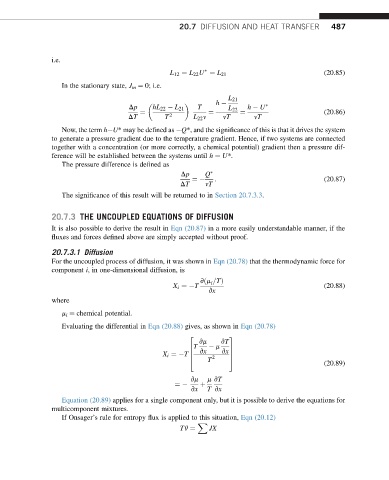Page 495 - Advanced thermodynamics for engineers
P. 495
20.7 DIFFUSION AND HEAT TRANSFER 487
i.e.
L 12 ¼ L 22 U ¼ L 21 (20.85)
In the stationary state, J m ¼ 0; i.e.
L 21
h
Dp hL 22 L 21 T L 22 h U
¼ ¼ ¼ (20.86)
DT T 2 L 22 v vT vT
Now, the term h U* may be defined as Q*, and the significance of this is that it drives the system
to generate a pressure gradient due to the temperature gradient. Hence, if two systems are connected
together with a concentration (or more correctly, a chemical potential) gradient then a pressure dif-
ference will be established between the systems until h ¼ U*.
The pressure difference is defined as
Dp Q
¼ : (20.87)
DT vT
The significance of this result will be returned to in Section 20.7.3.3.
20.7.3 THE UNCOUPLED EQUATIONS OF DIFFUSION
It is also possible to derive the result in Eqn (20.87) in a more easily understandable manner, if the
fluxes and forces defined above are simply accepted without proof.
20.7.3.1 Diffusion
For the uncoupled process of diffusion, it was shown in Eqn (20.78) that the thermodynamic force for
component i, in one-dimensional diffusion, is
vðm =TÞ
i
X i ¼ T (20.88)
vx
where
m i ¼ chemical potential.
Evaluating the differential in Eqn (20.88) gives, as shown in Eqn (20.78)
2 3
vm vT
T m
7
6
X i ¼ T 6 vx vx 7
T
4 2 5
(20.89)
vm m vT
¼ þ
vx T vx
Equation (20.89) applies for a single component only, but it is possible to derive the equations for
multicomponent mixtures.
If Onsager’s rule for entropy flux is applied to this situation, Eqn (20.12)
X
Tq ¼ JX

